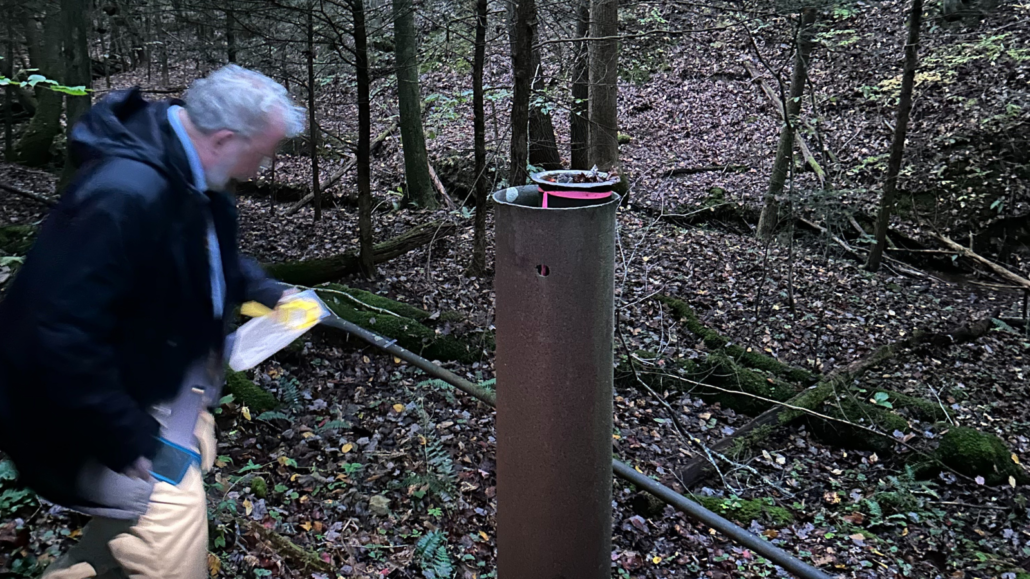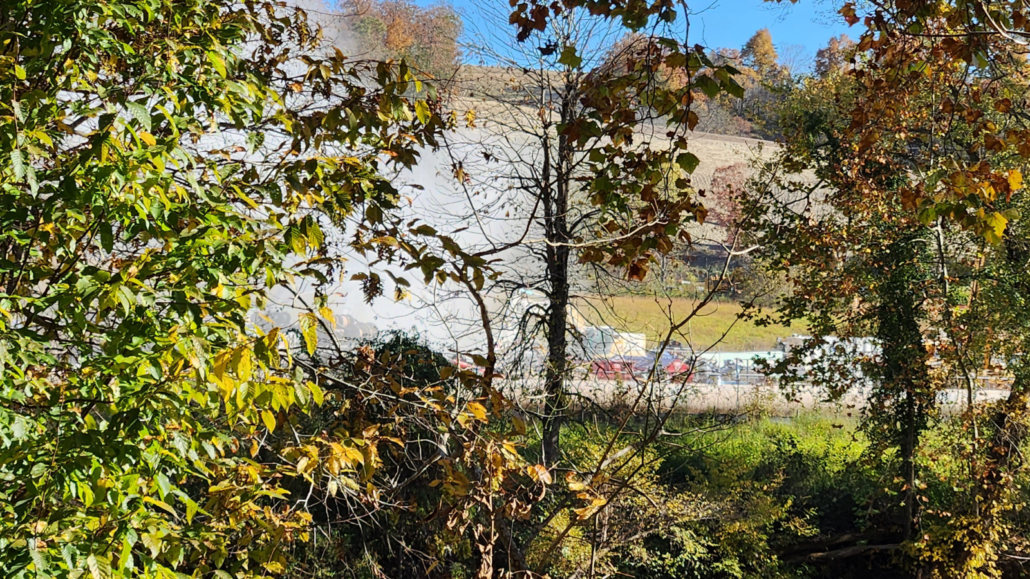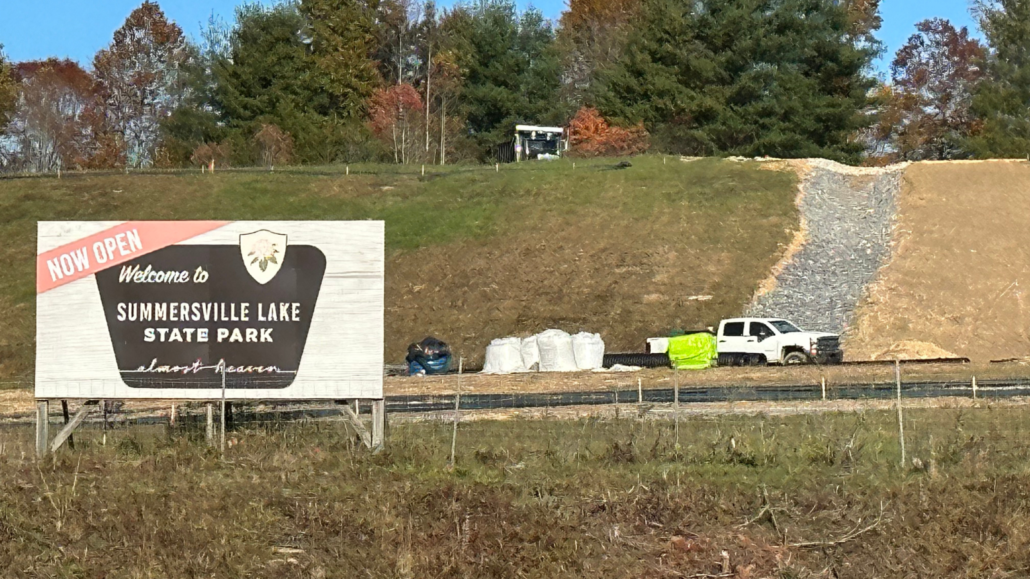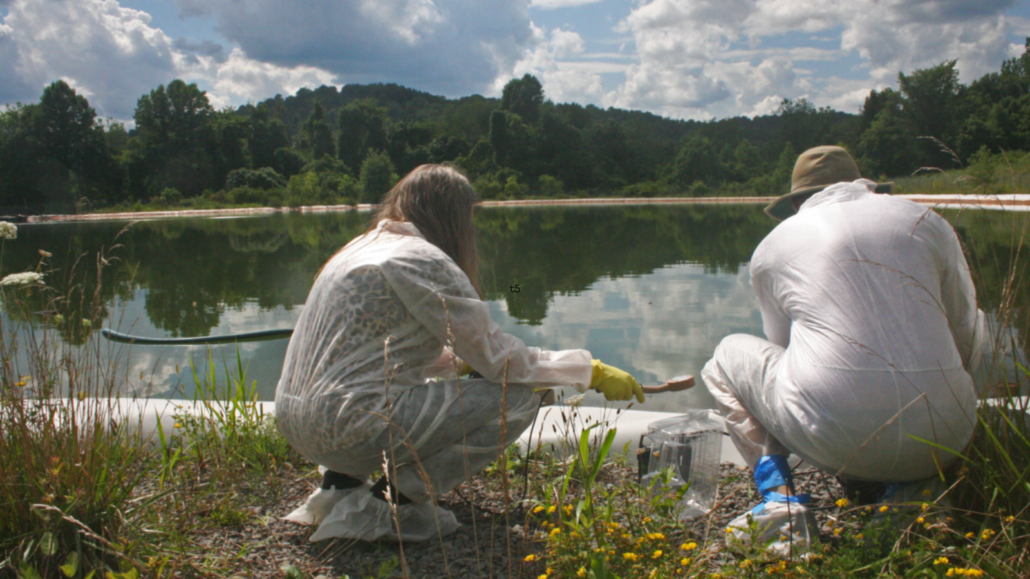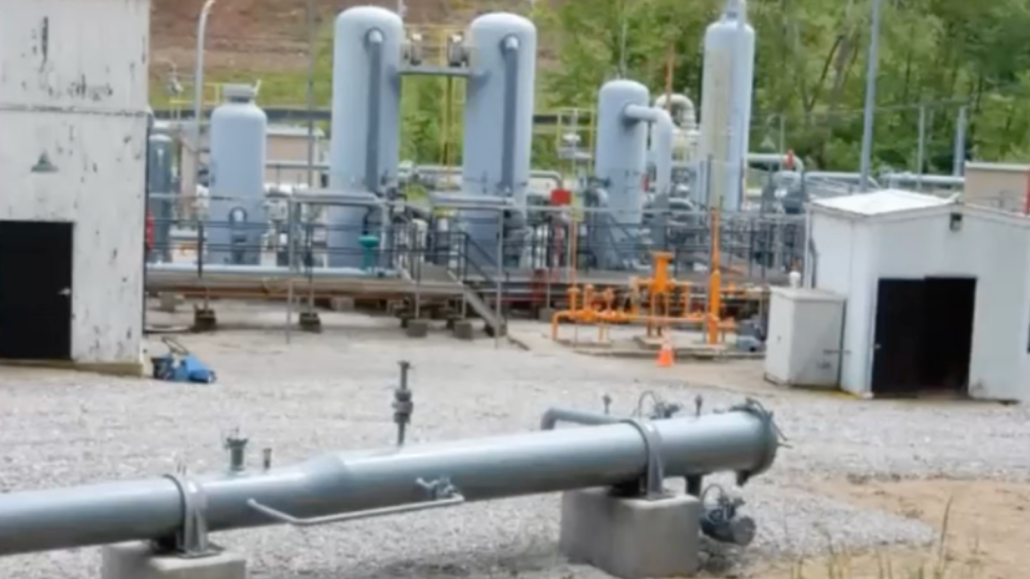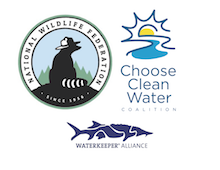The Bone-chilling Realities Facing West Virginians and Our Environment
Happy Halloween, everyone! In this edition of our monthly E-News, we’re diving into the bone-chilling realities facing residents of the Mountain State, from PFAS contamination to leaking oil & gas wells, and other dangerous pollutants impacting the air we breathe and the water we drink.
The Abandoned and Orphaned Oil & Gas Wells of the Kanawha State Forest
Public Lands Coordinator Mike Jones recently joined a group of environmental advocates for an eye-opening hike at Kanawha State Forest. Abandoned oil and gas infrastructure is prolific throughout the state. This hike aimed to inspect orphaned wells within the forest.
Shortly after the hike began, they encountered an orphaned well leaking methane gas, which triggered the methane monitoring device to light up like a jack-o-lantern. Moving down Polly Hollow trail, hikers saw a successfully plugged well and an operational one nearby. These juxtaposed examples emphasized the importance of responsible well management and the need to regulate methane emissions.
As the group continued along the trail, they passed a drip, smelling the distinct odor of gas in the air. This sensory experience underlined the very real dangers posed by gas leaks. A short distance further, an old orphaned well showcases a more unusual phenomenon. When it rains, passersby can actually see gas bubbling out of the well. That well is pictured above.
This eerie hike in our state’s public lands was a powerful reminder of the invisible threats that lie beneath the surface. It’s critical that we prevent oil and gas companies from walking away from leaking wells and enact strong regulations on methane emissions.
West Virginia Surface Owners’ Rights Organization is reporting the leaks. If you suspect an abandoned and leaking oil and gas well, report it to the WVDEP Spill line at 1-800-642-3074.
Air and Water Woes Worsen as Mountain Valley Pipeline Progresses: Residents Urged to Preserve Samples
The Mountain Valley Pipeline (MVP) project continues to encounter setbacks as its budget increases and completion date is once again pushed back. Recent citizen oversight revealed alarming air quality concerns during the project’s construction process.
Program Director Autumn Crowe called in a pollution event to the DEP Emergency Spill Line following a water quality monitoring training. Air pollution was observed coming from the MVP, where it is boring under the Greenbrier River in Summers County. (Pictured above.)
The air pollution turned out to be dust from the addition of lime to the water leaving the borehole. Fine particulates, such as lime dust, can still be hazardous when breathing, especially if individuals downwind have respiratory issues such as asthma. We urge local residents to report any dust migrating off their construction area to the WVDEP Air Quality Complaints.
Since construction resumed, nearby residents have reported impacts to their drinking water. The POWHR Coalition and WV Rivers Coalition advise community members to monitor their water for any changes in quality, quantity, pressure, or appearance.
Click the button below to read our letter to community members on the route of the Mountain Valley Pipeline.
Forever Chemicals: The Sinister Toxins in West Virginia’s Waters and Soil
PFAS are a group of man-made chemicals that have been used in a wide range of products for decades. Their nonstick and water-repellent properties have made them popular in Teflon cookware, stain-resistant fabrics, and firefighting foams. However, their insidious nature lies in their persistence in the environment, earning them the sinister nickname “forever chemicals.”
West Virginia, known for its picturesque landscapes and tight-knit communities, is grappling with a sinister specter — contaminated water supplies and soil tainted with PFAS. Many of these compounds have been detected in the drinking water of communities across the state, turning a basic human need into a health hazard.
PFAS compounds are a frightening foe for a number of reasons:
- Environmental Persistence: PFAS don’t break down easily, leading to long-lasting contamination in soil and water. They can linger for centuries, poisoning ecosystems and endangering wildlife.
- Bioaccumulation: These chemicals have a horrifying tendency to accumulate in living organisms, particularly in the fatty tissues of animals. This bioaccumulation can lead to high levels of PFAS in the food chain, ultimately affecting humans who consume contaminated food and water.
- Health Hazards: Studies have linked exposure to PFAS to a range of health problems, including cancer, liver damage, immune system disruption, and developmental issues in children. These potential health effects cast a chilling shadow over affected communities.
WV Rivers is shedding light on this ominous threat to our communities and working with our state’s regulatory agencies to address this toxic legacy. WVDEP was recently awarded a grant by EPA to work with WV Rivers to engage communities in developing PFAS Action Plans.
The Mystery of Summersville Lake State Park
On October 24, 2023, the State Agencies held a public meeting that promised to shed light on West Virginia’s enigmatic addition to its state park repertoire — Summersville Lake State Park. However, as the presentations unfolded and the officials spoke, the veil of mystery surrounding this park only seemed to deepen.
While we commend the state for bringing high-ranking officials to local venues to discuss our public lands, we find ourselves still in the shadows. Transparency, we believe, is the key. Public meetings of this nature should offer virtual options for those who cannot attend in person, and materials distributed should be made readily available online. You can view distributed materials here.
The presentation boldly asserted that this new park would be solely dedicated to outdoor recreation. While we wholeheartedly endorse the promotion of outdoor activities, we must not forget the fundamental purpose of State Parks – to conserve and protect the unique natural wonders of West Virginia. What, then, lies beneath the surface of this seemingly recreational paradise?
As the night progressed, queries swirled like specters in the minds of those present. What are the specifics of lake access? How will permits be handled? What about sewer hookups? And what of the construction already underway? These questions remain like ghosts in the moonlight, their answers seemingly just out of reach.
If you wish to venture further into the unknown, you may contact Secretary Bailey at James.M.Bailey@wv.gov and Director McMillion at Brett.W.McMillion@wv.gov.
An Abandoned Fracking Waste Site Has Become A Popular Party Spot, But Something Toxic Lurks
Hidden beneath the ground lies a dark secret that most Americans are blissfully unaware of. It’s a tale of toxic and radioactive brine, a sinister byproduct of oil and gas extraction that has haunted the nation for over a century. This substance, bearing names innocent and misleading, is far from benign. In its depths lurk salts, heavy metals, and radioactivity.
A recent article by Justin Nobel lays out the frightening background of a dangerous abandoned fracking waste processing plant site in Fairmont, WV.
From the 1860s to the 1980s, oilfield brine was careless dumped into pits, creeks, and other places. Nowadays, almost 97% of this harmful mix goes into injection wells, causing earthquakes and risking our water sources.
In 2009, a plant called AOP Clearwater, later known as Fairmont Brine Processing, opened. It promised to turn brine into useful things. But by 2015, the company disappeared, leaving behind unanswered questions and a radioactive problem.
In 2016, a shocking truth came to light. Fairmont Brine’s permit wrongly downplayed the amount of radioactive elements, especially radium-226, which takes 1,600 years to break down. Data showed that Marcellus brine was the most radioactive in the nation.
On May 30, 2023, a big explosion rocked the Fairmont Brine processing plant. While the report showed the danger, there were mixed messages. According to reports from WBOY and WDTV, the Department of Environmental Protection said there was no contamination, raising serious questions about how much danger was really there.
The ruins of Fairmont Brine hold a scary truth. Graffiti and trash show that people frequent the site to party, unaware of the radiation. A deadly substance called Polonium-210 is in the soil, posing a serious threat to anyone who steps on this dangerous ground.
EPA recently set up a webpage and phone line (800-438-2474) for Fairmont residents to get more information about the Fairmont Brine Processing site.
Read more about this toxic site in an article by Justin Nobel, who shared the above photo with us, by clicking the button below.
Ghostly Gas: Unanswered Questions Loom in the Depths of ARCH2
In mid-October, the Biden Administration announced they had selected the proposed Appalachia Regional Clean Hydrogen Hub (ARCH2) for up to $925 million in federal support. ARCH2 would depend on fracked gas to produce “blue” hydrogen through a network of industrial partners across parts of West Virginia, southeastern Ohio, and southwestern Pennsylvania.
The Chemours Company, Dominion Energy, Empire Diversified and EQT are some of the companies investing in this large, unprecedented project.
Blue hydrogen supporters claim that this network will help lower greenhouse gas emissions in certain sectors of our economy that are hard to de-carbonize, such as shipping and cement production. The carbon produced in this process is proposed to be captured and injected underground. Senators Joe Manchin and Shelley Moore Capito have celebrated this announcement and cite a predicted 18,000 construction jobs and 3,000 permanent jobs
The full details of ARCH2’s application and plan have not been released to the public, and community voices weren’t incorporated into the early stages of development. Many questions remain as to how DOE will prioritize the concerns of communities. During a public webinar hosted by DOE, our questions about how drinking water will be protected from further contamination by the fracked gas industry were unanswered.
In discussions with our supporters, we’ve heard three key concerns:
The promises of a vast web of carbon capture pipelines and injection wells are unproven at industrial scale
The fracked gas industry has not delivered promised jobs and economic prosperity — Blue Hydrogen may continue this cycle
Communities near fracked gas wells and wastewater storage facilities face serious health consequences that are not being addressed.
We’ll continue to keep our attention on ARCH2 as more information becomes available and are committed to help amplify the voices of West Virginia communities. Meanwhile, you can read more here about ARCH2 from Mike Tony with the Charleston Gazette-Mail.

